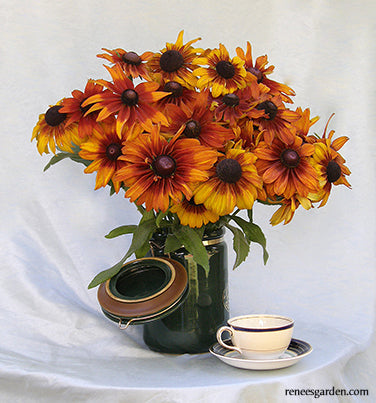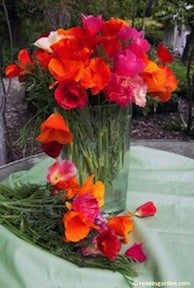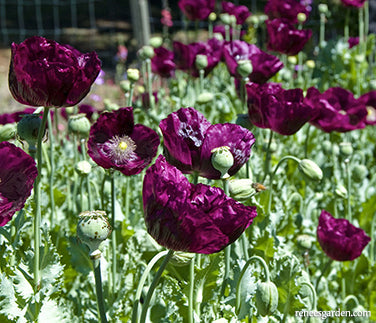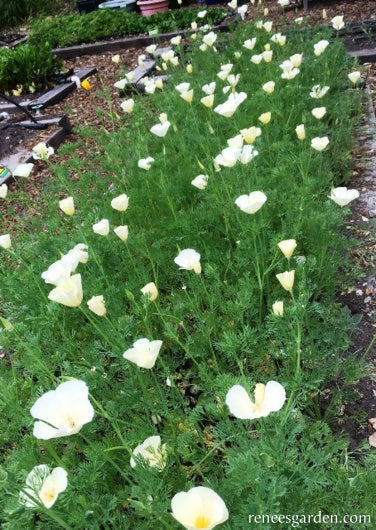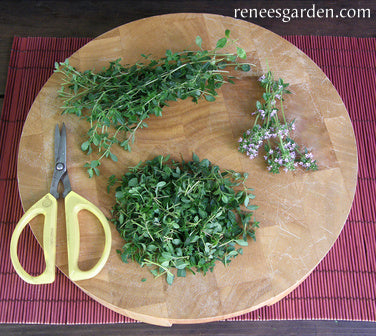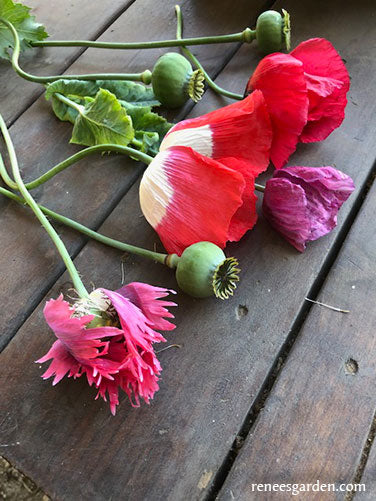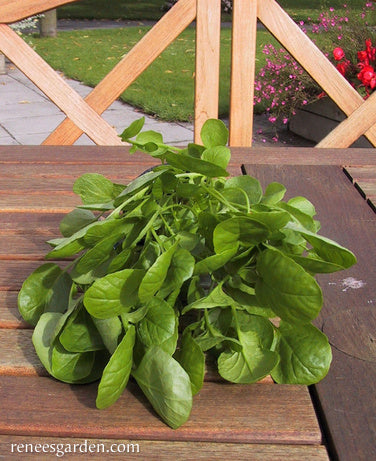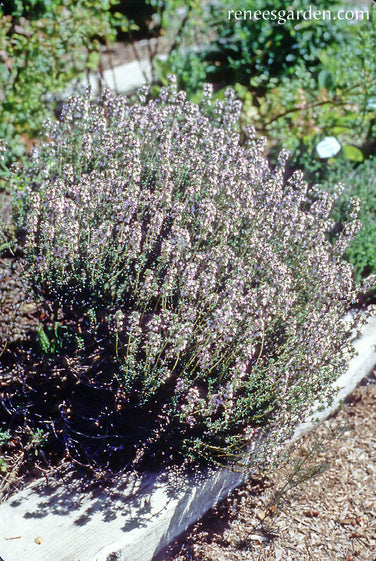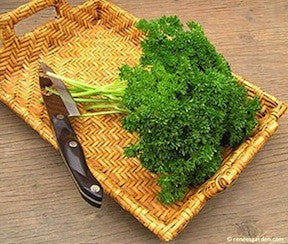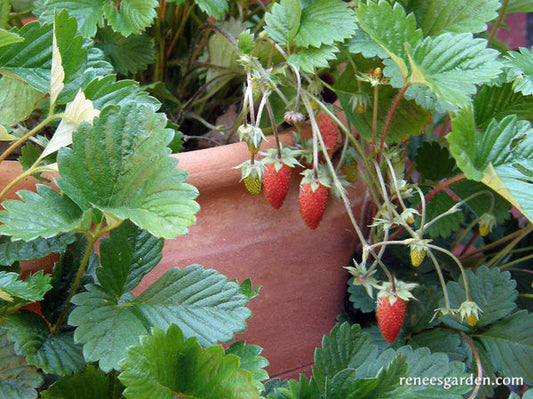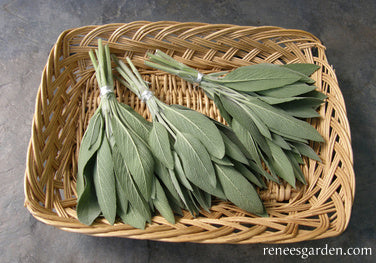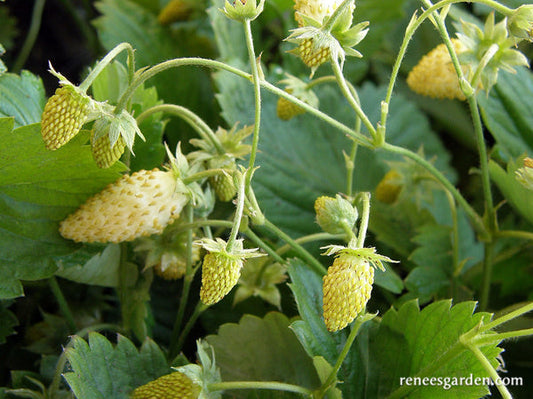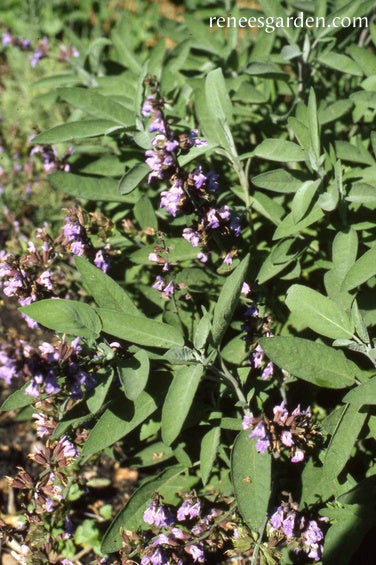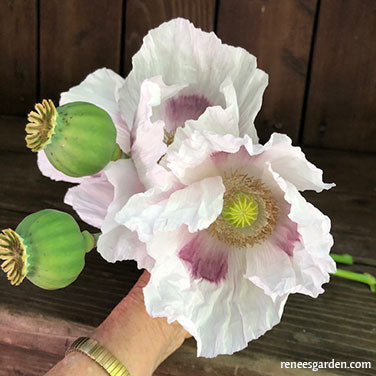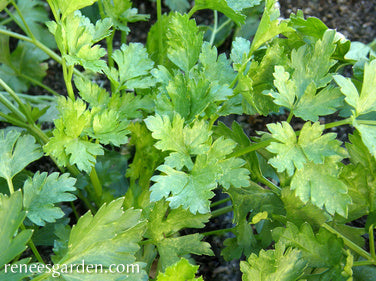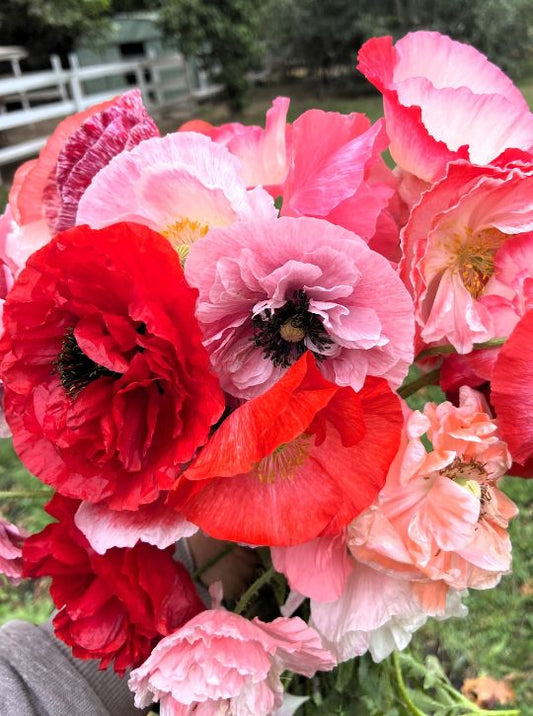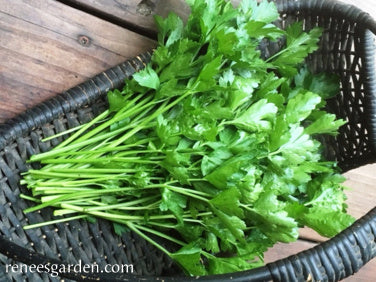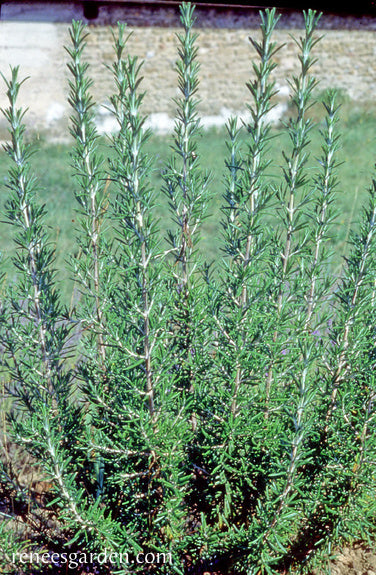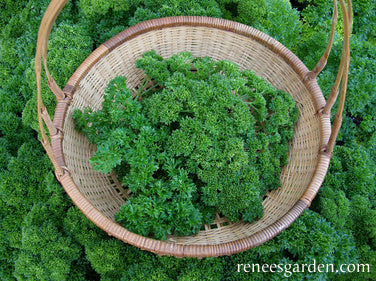Attracts Bees & Beneficials
Welcome Bee Friends and Others with Benefits
Plant these blooms to feed and nurture many kinds of beneficial insects from pollinators to pest control.
-
Shirley Poppies Falling In Love
ANNUAL
Spring/summer bloom
Frost hardyBEST TO START DIRECTLY IN THE GARDEN
Sow seeds directly into a finely textured garden bed in full sun as early in spring as ground can be worked. To help space these small seeds, it’s helpful to mix them with dry sand before sowing. Cover very lightly with fine soil and keep seed bed moist as seedlings emerge over 10 to 21 days.
THIN OR TRANSPLANT
Poppies do not transplant well, so we advise sowing the seeds directly in the garden. For good garden performance, be sure to thin crowded seedlings early; final plant spacing should be 4 to 6 inches apart, so plants have room to grow, mature and bloom.
GROWING NOTES
Plant as early as possible in spring, as poppies can handle frost and bloom best and longest when plants get a good start in cool weather. In mild winter climates, you can also sow seed in late fall to form strong root systems and overwinter for earliest spring bloom. Weed and water young seedlings carefully. Mature plants can handle dry conditions but appreciate regular water in hot summer locations. Poppies make good cut flowers if cut just as buds begin to open. Allow spent flowers to form pods and drop seed if you want flowers to self-sow for next season’s bloom.
Regular price $3.99Sale price $3.99Unit price / per -
Butterfly Rudbeckia Cappucino
PERENNIAL
Summer/fall bloom
Frost hardy
USDA Zones 4 to 9BEST TO START EARLY INDOORS
In spring, about 6 weeks before last expected frost date, sow seeds 1 inch apart in a containers of seed starting mix. Cover very lightly with mix, keep warm and moist, and provide a strong light source until seedlings are ready to plant out. Feed every 2 weeks with half strength fertilizer. Once seedlings are large enough to handle, transplant 2 to 3 inches apart into deeper containers or individual pots so root systems have room to develop. When plants are 3 to 4 inches tall, gradually acclimate to outdoor conditions. Plant out in the garden in full sun in well-drained, good soil 12 to 18 inches apart. Protect seedlings from slugs and snails while plants are young.
GROWING NOTES
These sturdy tetraploid Rudbeckias are easy to grow, naturalize well and require little maintenance other than removing faded flowers for longest bloom. Once established, they can handle a wide range of weather conditions and will bloom stronger each season. Plants send up long stems of 3 to 4 inch daisy-shaped blossoms in an array of warm colors and bicolors beginning at midsummer.Regular price $4.69Sale price $4.69Unit price / per -
California Poppies Tropical Sunset
PERENNIAL/GROWN AS ANNUAL
Spring/Summer bloom
Can handle light frostBEST TO START DIRECTLY IN THE GARDEN
Sow seeds directly into a finely textured, well-drained garden bed in full sun as early in spring as the ground can be worked. Plant as early as possible in spring, as poppies can handle light frost and bloom best and longest when plants get a good start in cool weather. In mild winter climates, Poppies can also be sown in late fall to overwinter for spring bloom.
Except in very poor soil, these California poppies will grow and flower readily with no added fertilizer. Space seeds several inches apart, cover 1/4 inch deep, and firm soil gently. Keep soil moist as seedlings emerge. Weed young seedlings carefully. If seedlings come up very thickly, thin poppies early but delay final thinning until seedlings are well established in spring. Final spacing should be 6 inches apart as plants need room to grow and bloom.
GROWING NOTES
When mature, poppy plants can handle dry conditions, but they will always bloom longer if regularly watered. Poppies are pretty cut flowers if brought indoors just as buds begin to open. At season’s end, allow spent flowers to form pods and drop seed if you want poppies to self-sow for next years flowers.Regular price $3.39Sale price $3.39Unit price / per -
Heirloom Poppies Lauren's Dark Grape
HARDY ANNUAL
Spring/summer bloom
Frost hardySTART SEEDS OUTDOORS
Plant poppies either in late fall or very early spring. (Fall-sown seeds will overwinter and germinate when soil warms in early spring.) If spring planting, sow in a fine-textured garden bed in full sun as early as the ground can be worked.
Broadcast seeds as thinly and evenly as possible and rake in gently, or lightly cover 1⁄8 inch deep. Keep seedbed moist. Seedlings emerge in 7 to 14 days. If seedlings come up very thickly, thin poppies early but delay final thinning until weather is settled in spring.
THIN OR TRANSPLANT
Poppies don’t transplant well, so sow directly in the garden. Thin early if crowded, then again to a final spacing 8 to 10 inches apart.
GROWING NOTES
Sow seeds early if spring planting, as poppies can handle frosts and bloom best when plants get a good start in cool spring weather. To help space the tiny seeds, try mixing them with a little dry sand before sowing. Weed and water young seedlings and thin carefully to final spacing once well established because poppies need room to grow and mature. Prolong bloom by removing spent flowers.
Regular price $3.69Sale price $3.69Unit price / per -
California Poppies Buttercream
PERENNIAL GROWN AS ANNUAL
Spring/Summer bloom
Can handle light frostBEST TO START DIRECTLY IN THE GARDEN
Sow seeds directly into a finely textured, well-drained garden bed in full sun as early in spring as the ground can be worked. Plant as early as possible in spring, as poppies can handle light frost and bloom best and longest when plants get a good start in cool weather. In mild winter climates, poppies can also be sown in late fall to overwinter for spring bloom. Except in very poor soil, these California poppies will grow and flower readily with no added fertilizer. Space seeds 2 or 3 inches apart, cover 1/4 inch deep, and firm soil gently. Keep soil moist as seedlings emerge. Weed young seedlings carefully. If seedlings come up very thickly, thin poppies early but delay final thinning until seedlings are well established in spring. Final spacing should be 3-4 inches apart as plants need room to develop and bloom.
GROWING NOTES
When mature, poppy plants can handle dry conditions but they will always bloom longer if watered regularly. Poppies are pretty cut flowers if brought indoors just as buds begin to open. Prolong bloom by removing spent flowers. At season's end, allow spent flowers to form pods and drop their seed if you want poppies to self-sow.Regular price $3.39Sale price $3.39Unit price / per -
Kitchen Herbs Creeping Thyme
PERENNIAL
Spring/summer/fall harvest
Frost hardyBEST TO START INDOORS
Sow in early spring in a container of seed starting mix. Cover seeds very lightly and keep evenly moist but not soggy until seedlings emerge in 14 to 21 days. Provide a good light source until ready to plant outside.
TO PLANT IN THE GARDEN
Sow creeping thyme in a finely textured seedbed in full sun after soil has warmed up in spring. Good drainage is essential. Sow very thinly, cover seeds lightly and carefully keep the seed bed evenly moist and well weeded as young seedlings are slow growing at first. Transplant when 2 to 3 inches tall after acclimating to outdoor conditions.
THIN OR TRANSPLANT
Space clusters of 3-4 seedlings 8 inches apart when large enough to handle so plants have room to grow and thrive.
GROWING NOTES
Given good drainage and a sunny location, easy-growing creeping thyme plants are reliable and productive garden perennials. Be sure to thin or transplant seedlings to proper spacing and keep weed free; plants will fill out and spread once well established. Little lavender-rose flowers bloom atop the shiny dense leaves at midsummer.Regular price $2.99Sale price $2.99Unit price / per -
Heirloom Poppies Pepperbox Poppy
ANNUAL
Spring/summer bloom, fall harvest
Frost hardyEASIEST TO START OUTDOORS
Plant poppies in late fall or very early spring directly into the garden. In cold winter climates, seeds will overwinter and germinate when soil thaws. Blossoms and pods are largest when plants grow in cool weather; seedlings are very cold hardy.
In a well-worked, finely textured seed bed in full sun, sprinkle seeds thinly (mixing dry sand with the seeds will help space them). Rake in gently or lightly cover seeds 1/8 inch deep and keep seed-bed moist until seedlings emerge in 7 to 14 days. If seedlings come up too thickly, thin poppies early, but delay final thinning to 6 to 8 inches apart until weather has settled in spring.
HARVEST & USE
Wait until seedpods are dried and brown on plants and the tiny seeds inside pods are hard and black. Cut seedpods with long stems and bunch upside down in an open paper bag. Shake seeds out into bag and remove any debris. Store clean seed in a closed jar or freeze for long storage.
Toasted Poppy seeds’ nutty flavor enhances both sweet and savory breads, cakes and cookies and is delicious in salad dressing.
Regular price $3.39Sale price $3.39Unit price / per -
Heirloom Miniature Roses Angel Wings
PERENNIAL
Perennial
Summer/Fall Bloom
Very Hardy USDA Zones 4-9START EARLY INDOORS
In spring, 6 weeks before last expected frost date, sow seeds 2 inches apart in a container of seed starting mix and cover 1/4 inch deep. Keep cool, between 60-70°F (16-27°C) and moist and provide a strong light source until ready to plant out. Rose seeds germinate slowly, so be patient. Once seedlings are large enough to handle, transplant into individual pots. Feed seedlings every 2 weeks with half-strength fertilizer. When 3 to 4 inches tall, gradually acclimate seedlings to outdoor conditions and plant out in full sun.
THIN OR TRANSPLANT
Space seedlings 18 inches apart so plants can mature and spread.
GROWING NOTES
Set young seedlings out into rich, well-drained fertile soil or plant in large containers to grow into charming patio shrubs. Plants may flower sparsely their first summer, then begin to bloom in earnest their second and third seasons. They mature at 1 1/2 to 2 1/2 feet tall and are covered with sprays of delicate pastel blossoms all summer long. Keep faded flowers cut off and fertilize regularly for new beautiful garden displays and dainty little nosegay bouquets.
Regular price $4.99Sale price $4.99Unit price / per -
Heirloom Herbs English Watercress
BIENNIAL/GROWN AS ANNUAL
Spring/fall harvest
Can handle some frostSTARTING SEEDLINGS
Watercress is a cool weather crop. Make successive sowings several weeks apart to have a constant supply, starting in early spring. Plant watercress in a pot of seed starting mix and keep in a cool spot. Sow seeds one inch apart, do not cover with mix, but keep thoroughly moist. Germination should occur in about a week. Late summer-sown watercress will last well into cold weather.
THIN OR TRANSPLANT
Space seedlings 2 to 3 inches apart when they are large enough to handle.
GROWING NOTES
Set out seedlings next to a source of clean, fresh flowing water or water them daily. Watercress grown in pots can be set in saucers of water, which must be changed regularly to imitate a moving stream. Or, set your seeded pot right under an often-used hose bib to benefit from stray sprinkles and drips. Snip back growing shoots to make plants branch from the base and harvest tender tips as needed. As flowers begin to bud up, leaves get smaller and their taste gets bitter, so pull and pick from younger plants.Regular price $3.39Sale price $3.39Unit price / per -
Kitchen Herbs French Thyme
PERENNIAL
Spring/summer/fall harvest
Frost hardyBEST TO PLANT INDOORS
Sow thyme in early spring in a container of seed starting mix. Cover seeds very lightly and keep evenly moist but not soggy until seedlings emerge in 14 to 21 days. Provide a good light source. When seedlings are 2 inches tall, gradually acclimate to outdoor conditions and transplant clusters of 3-4 seedlings 8-10 inches apart.
TO START IN THE GARDEN
Plant thyme after soil has warmed up in spring in a finely textured seed bed with good drainage in full sun. Sow very thinly, cover seed lightly and be careful to keep the seed bed evenly moist and well weeded. When seedlings are several inches tall, thin out, leaving clumps of 3-4 seedlings 8-10 inches apart so plants have room to grown and spread.
GROWING NOTES
Given a sunny location with good drainage, easy-growing thyme plants are reliable productive and long-lived garden perennials. Little lilac flowers bloom in midsummer; cut back foliage halfway when the blossoms fade to keep plants looking fresh. Cut leafy thyme sprigs as needed once plants are well established.Regular price $2.99Sale price $2.99Unit price / per -
Kitchen Herbs Sweet Curly Parsley
TO PLANT DIRECTLY IN THE GARDEN
In spring when weather is settled but still cool, sow seeds 1 to 2 inches apart into well-worked fertile soil in full sun and cover 1/4 inch deep. If climate is very hot, plant in a spot with morning sun and afternoon shade. Parsley germinates unevenly over several weeks; be patient and keep seed bed evenly moist.
TO START EARLY INDOORS
Sow parsley seeds in early spring in a container of seed starting mix. Cover 1/4 inch deep, and keep container moist but not soggy until seedlings emerge. Provide a good light source. Feed seedlings frequently until ready to transplant when about 2 inches tall after acclimating to outdoor conditions.
THIN OR TRANSPLANT
Space 3 to 4 inches apart when seedlings have several sets of leaves.
GROWING NOTES
Parsley needs rich moist soil and ample spacing for lush harvests. Thin early and keep well weeded and watered. Begin to harvest sparingly once plants have 8 to 10 leaves. Fertilize monthly with a high nitrogen source for best leafy growth.Regular price $2.99Sale price $2.99Unit price / per -
Alpine Strawberries Mignonette
BEST TO START EARLY INDOORS
In spring, sow seeds 1 inch apart and 1⁄8 inch deep in a container of fine seed starting mix. Maintain at 60-70°F (15-21°C). Provide a strong light source. Keep evenly moist but not soggy. Be patient: seeds take 14-28 days to germinate. Feed young seedlings every 2 weeks with half-strength fertilizer. When they have several sets of leaves, transplant 3 inches apart into a deeper container or individual pots so root systems have room to develop. When 3 inches tall, gradually acclimate to outdoor conditions and plant 12 inches apart in fertile soil in full sun or partial shade in very hot climates.
GROWING NOTES
Plant in window boxes or hanging baskets, or as a pretty edging along a garden path or border. Mignonette plants bear sweet 1 inch fruits the first season after sowing and grow about a foot across without sending out runners. Feed and water regularly and plants will continue to fruit for 2 to 4 years.
HARVEST AND USE
Pick and enjoy these petite perfumed berries when they turn a deep red and give slightly to the touch. Sprinkle over morning cereal or nestle the ruby colored berries on tiny tarts or cakes.Regular price $3.99Sale price $3.99Unit price / per -
Heirloom Herbs Italian Aromatic Sage
PERENNIAL
Spring/summer/fall harvest
Frost hardyBEST TO START EARLY INDOORS
In early spring, sow seed 1 inch apart in a container of seed starting mix and cover 1⁄4 inch deep. Keep evenly moist as seedlings emerge and provide a strong light source until ready to plant outdoors. Transplant 12 to 18 inches apart when seedlings are about 2 or 3 inches tall after gradually acclimating plants to outdoor conditions.
TO PLANT OUTDOORS
Sow seeds 1 inch apart in well-drained fertile soil in full sun in spring once weather is warm and settled. Cover 1/4 inch deep, firm soil over seeds and keep seedbed evenly moist. Germination takes 2 to 3 weeks. After seedlings are well established, thin or transplant 12 to 18 inches apart.
GROWING NOTES
Sage plants are resilient and drought tolerant once established. Cut leafy sprigs once plants are well leafed out. After flowers stop blooming, cut them well down the branch to encourage more leaf growth. Add a small pinch of crushed fresh sage to vegetables, casseroles, pork, poultry stuffing and cheese dishes. Combine fresh sage with chopped parsley to mellow its pungency. To dry, hang leafy branches upside down in a cool airy place.Regular price $2.99Sale price $2.99Unit price / per -
Alpine Strawberries Heirloom Pineapple
PERENNIAL
Spring/summer/fall harvest
Frost hardyBEST TO START EARLY INDOORS
In spring, sow seeds 1 inch apart and 1⁄8 inch deep in a container of fine seed starting mix. Maintain at 60–70°F (16-21°C) and provide a strong light source. Keep evenly moist but not soggy. Be patient, seeds can take 14 to 28 days to germinate. Feed young seedlings every 2 weeks with half-strength fertilizer. When they have several sets of leaves, transplant 3 inches apart into a deeper container or individual pots so root systems have room to develop. When 3 inches tall, gradually acclimate to outdoor conditions and plant 8-10 inches apart in fertile soil in full sun or partial shade in very hot climates.
GROWING NOTES
Plant in windowboxes or hanging baskets, or as a pretty edging along a garden path or border. Heirloom Pineapple bears sweet 1 inch fruits the first season after sowing. Plants grow about a foot across without sending out runners. Feed and water regularly and plants will continue to fruit for 2 to 4 years.
HARVEST AND USE
Pick and enjoy these petite perfumed berries when they turn a pastel yellow and give slightly to the touch. Sprinkle over morning cereal or nestle the berries on tarts or cakes.Regular price $3.99Sale price $3.99Unit price / per -
Heirloom Culinary Sage
BEST TO START EARLY INDOORS
In early spring, sow seed 1 inch apart in a container of seed starting mix and cover 1/4 inch deep. Keep evenly moist as seedlings emerge and provide a strong light source until ready to plant outdoors. Transplant 12 to 18 inches apart when seedlings are about 2 or 3 inches tall after gradually acclimating plants to outdoor conditions.
TO PLANT OUTDOORS
Sow seeds 1 inch apart in well drained fertile soil in full sun in spring once weather is warm and settled. Cover 1/4 inch deep, firm soil over seeds and keep seedbed evenly moist. Germination takes 2 to 3 weeks. After seedlings are well established, thin or transplant 12 to 18 inches apart.
GROWING NOTES
Sage plants are resilient and drought tolerant once established. Cut leafy sprigs once plants are well filled out. After flowers stop blooming, cut them well down the branch to encourage more leaf growth. Add a small pinch of crushed fresh sage to vegetables, casseroles, pork, poultry stuffing and cheese dishes. Combine fresh sage with chopped parsley to mellow its pungency. To dry, hang leafy branches upside down in a cool airy place.Regular price $4.89Sale price $4.89Unit price / per -
Heirloom Poppies Hungarian Breadseed Poppy
ANNUAL
Spring/summer bloom
Fall harvest
Frost hardyEASIEST TO START OUTDOORS
Plant poppies in late fall or very early spring directly into the garden. In cold climates, seeds will overwinter and germinate when soil thaws. Blossoms and pods are largest when plants grow in cool weather; seedlings are very cold hardy. In a well-worked, finely textured seed bed in full sun, sprinkle seeds as thinly as possible or sow in rows 8 to 10 inches apart. (Mixing dry sand with the seeds will help space them.) Rake in gently or lightly cover seeds 1/8 inch deep, and keep seed bed moist until seedlings emerge in 7 to 14 days. If seedlings come up too thickly, thin poppies early, but delay final thinning to 6 to 8 inches apart until weather has settled in spring.
GROWING NOTES
Flowers will bloom in spring and early summer, then drop their petals and form fat seed capsule pods. When pods get brown and hard, cut and store them in open paper bags. When completely dry, crack pods open to remove seeds. Store harvested poppy seed in the freezer to keep it fresh and pest free.
Regular price $3.39Sale price $3.39Unit price / per -
Heirloom Parsley Italian Large Leaf
EASIEST TO START OUTDOORS
Start parsley in spring when weather is settled but still cool and/or in late summer in mild winter climates. Plant in full sun or half-day sun if climate is very hot. Sow seeds 1- 2 inches apart into a well-worked fertile seed bed. Cover 1/4 inch deep. Parsley germinates unevenly over several weeks; be patient and keep seed bed evenly moist. Using synthetic row covers to hold moisture during germination is helpful; remove when seedlings are well established.
TO PLANT INDOORS
In early spring, sow seeds 1 inch apart and 1/4 inch deep in a container of seed starting mix. Keep container moist but not soggy until seedlings emerge. Provide a good light source. Feed seedlings frequently until ready to transplant when several inches tall.
THIN OR TRANSPLANT
Space 3 to 4 inches apart when seedlings large enough to handle.
GROWING NOTES
Parsley needs rich moist soil and ample spacing for lush harvests. Thin early and keep well weeded and watered. Begin to harvest sparingly once plants have 8 to 10 leaves. Fertilize frequently with a high nitrogen source.Regular price $4.89Sale price $4.89Unit price / per -
Shirley Poppies Angels' Choir
ANNUAL
Spring/summer bloom
Frost hardyBEST TO START DIRECTLY IN THE GARDEN
Sow seeds directly into a finely textured garden bed in full sun as early in spring as ground can be worked. To help space the fine seeds, mix with dry sand before sowing. Cover very lightly with fine soil and keep seed bed moist as seedlings emerge over 7 to 21 days.
THIN OR TRANSPLANT
Poppies do not transplant well so we advise sowing the seeds directly in the garden. To get good garden performance, be sure to thin crowded seedlings early; final plant spacing should be 6 to 8 inches apart, so plants have room to grow, mature and bloom.
GROWING NOTES
Plant as early as possible in spring, as poppies can handle frost and bloom best and longest when plants get a good start in cool weather. In mild winter climates, sow seed in late fall to overwinter for spring bloom. Weed and water young seedlings carefully. Mature plants can handle dry conditions but appreciate regular water in hot summer locations. Poppies make good cut flowers if cut just as buds begin to open. Allow spent flowers to form pods and drop seed if you want flowers to self-sow for next season’s bloom.Regular price $3.99Sale price $3.99Unit price / per -
Hummingbird Penstemon Wedding Bells
PERENNIAL
Spring/Summer bloom
Hardy to zone 4BEST TO START INDOORS
Start indoors in early spring, spacing seeds 1/2–1 inch apart in a container of seed starting mix. Cover very lightly, no more than 1/8 inch deep and keep evenly moist but not soggy as germination takes 14 to 28 days. Provide a strong light source for seedlings.
Once seedlings are large enough to handle, transplant to a deeper flat 3 inches apart or individual 3 or 4 inch pots. When plants are several inches tall, gradually acclimate to outdoor conditions, then plant in full sun 10 to 12 inches apart into fertile well-drained soil.
TO START OUTDOORS
Sow in a well-protected, fine textured seed bed once frost danger is past. Cover seeds very lightly with fine soil and keep evenly moist until germination occurs. Tend the tiny seedlings carefully and when large enough to handle, thin or transplant 8 to 10 inches apart.
GROWING NOTES
Wedding Bells often bloom the first year from seed. Given good drainage, these strong plants will continue to flower beautifully throughout each spring and summer. Their lovely colors make beautiful natural bouquets and they are long-lasting and alluring cut flowers. Plants are hot weather tolerant once established.
Regular price $3.39Sale price $3.39Unit price / per -
Kitchen Herbs Italian 'Gigante' Parsley
BIENNIAL, GROWN AS ANNUAL
Spring/summer/fall harvest
Frost hardyEASIEST TO START OUTDOORS
Start parsley in spring when weather is settled but still cool and/or in late summer in mild winter climates. Plant in full sun or half-day sun if climate is very hot. Sow seeds 1-2 inches apart into a well-worked fertile seed bed. Cover 1/4 inch deep. Parsley germinates unevenly over several weeks; be patient and keep seed bed evenly moist. Using synthetic row covers to hold moisture during germination is helpful; remove when seedlings are well established.
TO PLANT INDOORS
Sow parsley seeds in early spring in a container of seed starting mix. Cover 1/4 inch deep, and keep container moist but not soggy until seedlings emerge. Provide a good light source. Feed seedlings frequently until ready to transplant when several inches tall.
THIN OR TRANSPLANT
Space 3 to 4 inches apart when seedlings large enough to handle.
GROWING NOTES
Parsley needs rich moist soil and ample spacing for lush harvests. Thin early and keep well weeded and watered. Begin to harvest sparingly once plants have 8 to 10 leaves. Fertilize frequently with a high nitrogen source.Regular price $2.99Sale price $2.99Unit price / per -
Kitchen Herbs French Rosemary
BEST TO START INDOORS
In early spring, sow seeds an inch apart in fine seed starting mix. Cover seeds very lightly with mix. Maintain at 70°F (24°C) and provide a strong light source. While awaiting germination, be sure to keep the seed bed moist but not soggy. Be patient: these small perennial seeds germinate very slowly over 1 to 2 months.
When they have several sets of leaves, transplant seedlings into individual 4 to 6 inch pots so root systems have room to develop. When all danger of frost has past, plant 2½ feet apart in well-drained soil in full sun.
To grow in containers, transplant each plant into a pot with at least a 3 gallon capacity (or 12 inch pot).
GROWING NOTES
Like many perennial herbs, rosemary has a naturally low germination rate and grows slowly the first season. Plants thrive in hot, dry conditions and require well drained soil.
In mild climate areas (zones 8 through 10), where winters are mild and the ground doesn’t freeze, Perennial Rosemary plants grow into substantial shrubs in mild climates. In cold winter areas (zones 3 to 7), plant seedlings into large pots to enjoy throughout spring and summer. When weather gets cold and frost threatens, prune plants back heavily and bring pots inside to spend the winter indoors in a cool, well-lit area; water very sparingly while plants are overwintering indoors. In spring, when danger of frost is over and weather is settled, move potted plants back outside to a sunny spot.
HARVEST AND USE
Rosemary’s stiff straight branches make perfect skewers for grilling. Use leaves in marinades combined with lemon, garlic and oil. Stuff a roasting chicken with whole branches and use to season lamb. Sprinkle finely minced rosemary over potatoes; dust on cheese dishes, garlic bread, grilled tomatoes and root vegetables.Regular price $3.99Sale price $3.99Unit price / per -
Heirloom Sweet Parsley Triple Curled
BIENNIAL, GROWN AS ANNUAL
Spring/summer/fall harvest
Frost hardyTO PLANT DIRECTLY IN THE GARDEN
In spring when weather is settled but still cool, sow seeds 1 to 2 inches apart into well-worked fertile soil in full sun and cover 1/4 inch deep. If climate is very hot, plant in a spot with morning sun and afternoon shade. Parsley germinates unevenly over several weeks; be patient and keep moist.
TO START EARLY INDOORS
Sow parsley seeds in early spring in a container of seed starting mix. Cover 1/4 inch deep, and keep container moist but not soggy until seedlings emerge. Provide a good light source. Feed seedlings frequently until ready to transplant when about 2 inches tall after acclimating to outdoor conditions.
THIN OR TRANSPLANT
Space 4 to 6 inches apart when seedlings have several sets of leaves. Feed monthly for best results.
GROWING NOTES
Parsley needs rich moist soil and ample spacing for lush harvests. Thin early and keep well weeded and watered. Begin to harvest sparingly once plants have 8 to 10 leaves. Fertilize monthly with a high nitrogen source for best leafy growth.Regular price $4.89Sale price $4.89Unit price / per



